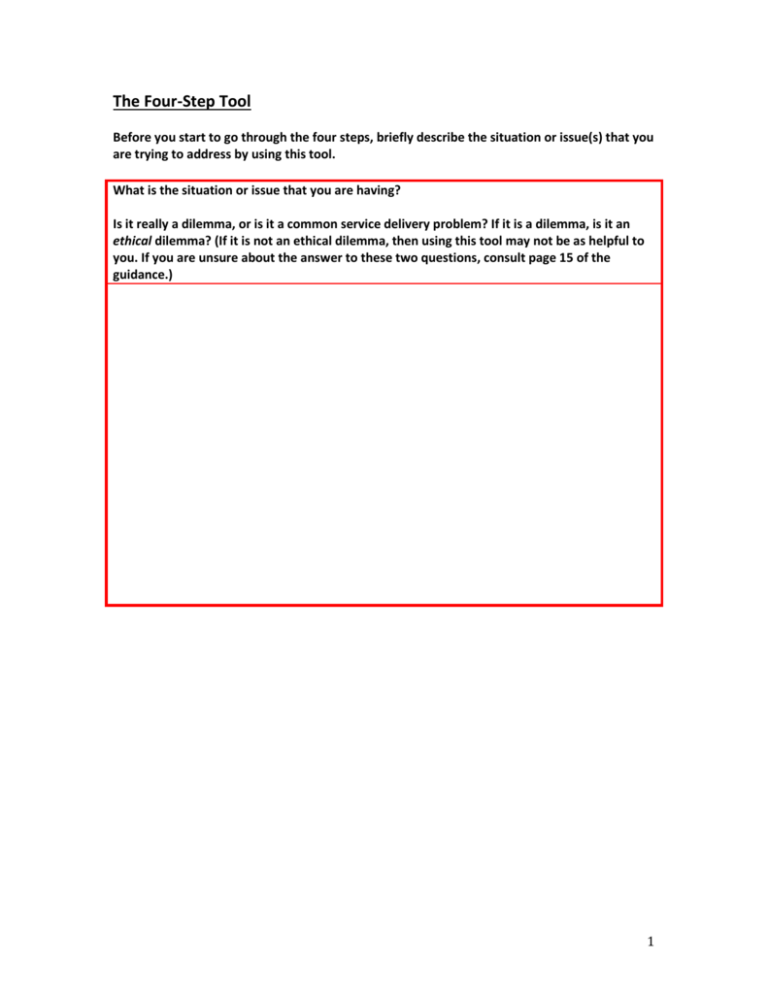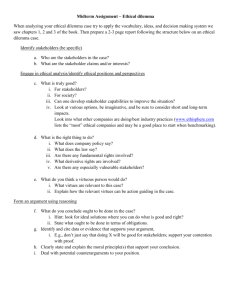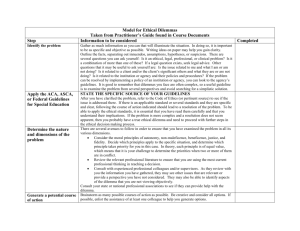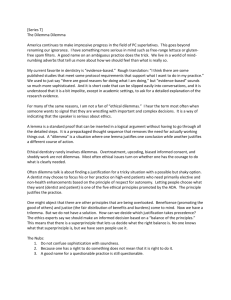The-Four-Step-Tool
advertisement

The Four-Step Tool Before you start to go through the four steps, briefly describe the situation or issue(s) that you are trying to address by using this tool. What is the situation or issue that you are having? Is it really a dilemma, or is it a common service delivery problem? If it is a dilemma, is it an ethical dilemma? (If it is not an ethical dilemma, then using this tool may not be as helpful to you. If you are unsure about the answer to these two questions, consult page 15 of the guidance.) 1 Step 1: The 4-Box Method to Identifying the Facts & Assumptions Adapted from Jonsen, Albert, Siegler, Mark and William J. Winslade (2002) Clinical Ethics: A Practical Approach to Ethical Decisions in Clinical Medicine, McGraw-Hill Medical; 5th edition. In each of the four boxes, there are a number of questions to prompt you to think about what important information you need in order to make a decision about the issue(s) that you are facing. Some of these questions may not be relevant to the issue(s) that you are trying to address, but they are designed to help identify what you know as facts, what you don’t know, what are assumptions, and where you need to find out more information Remember, it is not necessary to answer all of the questions. Health, Care, & Support Needs Client Preferences in this Situation For each client involved in the situation, think about the following questions, and answer as many as you think relevant: For each client involved in the situation, think about the following questions, and answer as many as you think relevant: What do you think the client’s needs are (e.g., health including treatment and medications; care; support; social needs, etc.), and are there other people whose needs should be considered? What about potential risks and harms? What other facts do you need? Be careful about unduly consulting with family or medical personnel who may, or may not have the best interest of the client in mind. Have you talked to the client about this situation? What are the client’s expressed preferences? Is there any reason to believe that the client does not have the ability to make decisions? If yes, who is the substitute decision maker? If no, are client’s wishes informed, understood, and voluntary? Is the client’s right to choose being respected? 2 Quality of Life Contextual Issues For each client involved in the situation, think about the following questions, and answer as many as you think relevant: For each client involved in the situation, think about the following questions, and answer as many as you think relevant: How has the client described the current situation to you in the context of life generally? What would it mean to the client if you could meet the needs and preferences described? What difference would it make in the client’s life? As a care worker, do you see it the same way? Consider emotions, feelings, values, biases and prior experiences of the people involved, including you. What are the consequences for you in supporting the client’s preferences? What is the relevant social, economic, and/or institutional context? Are there organizational values to consider? What laws might have a negative impact on your client(s)? What laws might influence your response? Has anything changed recently that affects the situation? What other services are or could be involved? What plans have been put in place so far? 3 Step 2: Determine the Ethical Values & Principles in Conflict Now that you’ve identified the facts, identify the ethical dilemma(s). Which ethical principles are in conflict? Refer to the list in the left column and to the full Code of Ethics and Ethical Values and Principles on pages 16. It may help to explain the issue(s) first by using the facts from Step 1, and then to identify the ethical values and principles that correspond to the issue(s). State the ethical dilemma by explaining which ethical values and principles are in conflict – there may be more than two. Circle the relevant ethical values & principles below: Dignity Diversity Advocacy Security Quality Accountability Privacy Confidentiality Managing Conflicting Obligations Fair and Equitable Access Health and Wellbeing Informed Choice Empowerment Cooperation Family Prioritizing children while supporting parents or caregivers in key populations Explain the Issue(s) 4 Based on Steps 1 & 2, what is/are the ethical dilemma(s)? 5 Step 3: Explore Options and consider their strengths and weaknesses Brainstorm all of the options that you can think of, even those that may not be ideal solutions. Brainstorm and discuss with peers as appropriate. Whenever possible, discuss the options with your client(s). Consider under what circumstance(s) you would not discuss the options with the client(s), and how you would justify that decision. Be creative and use your imagination. Consider a compromise. Think about the outcomes or consequences for each alternative. What is the good that might come of each option? What is the harm that might come of each option? Have the options you developed fit with the client(s)’s/family’s statement of values and preferences, and the information that you obtained from your client(s)? Question whether the alternatives meet relevant policies, directives and regulations. Make sure that you weigh the strengths and weaknesses of all of the options before you make a decision. Consider which options do the most good or the least harm. Consider what ethical principles each option upholds or what ethical principles each option violates. Consider also how practical it would be to act on each option. Option Strengths Weaknesses 6 Step 4: Choose an Option, Take Action, Evaluate and Debrief Develop an action plan (The actual plan should be documented) Given all the information that you have, choose the best option(s) available. Present alternatives to the client(s) and those involved. Re-examine the options if other factors come to light, if the situation changes, or if the client does not agree. Develop an action plan that includes what you are going to do and the steps that you are going to take. Determine when to evaluate the plan. Document and communicate the plan. The plan is: Evaluate the plan: What was the outcome of the plan? How did the client(s) feel about how the issue was resolved? Is there need for further action? Self-evaluate your decision and debrief with colleagues: How do you feel about the decision and the outcome? What would you do differently next time? What would you do the same? What have you learned about yourself? What have you learned about this decision-making process? What can your organization learn from this situation? What changes can the organization make to better support people making similar decisions? What changes can the organization make to better address these types of situations? 7






